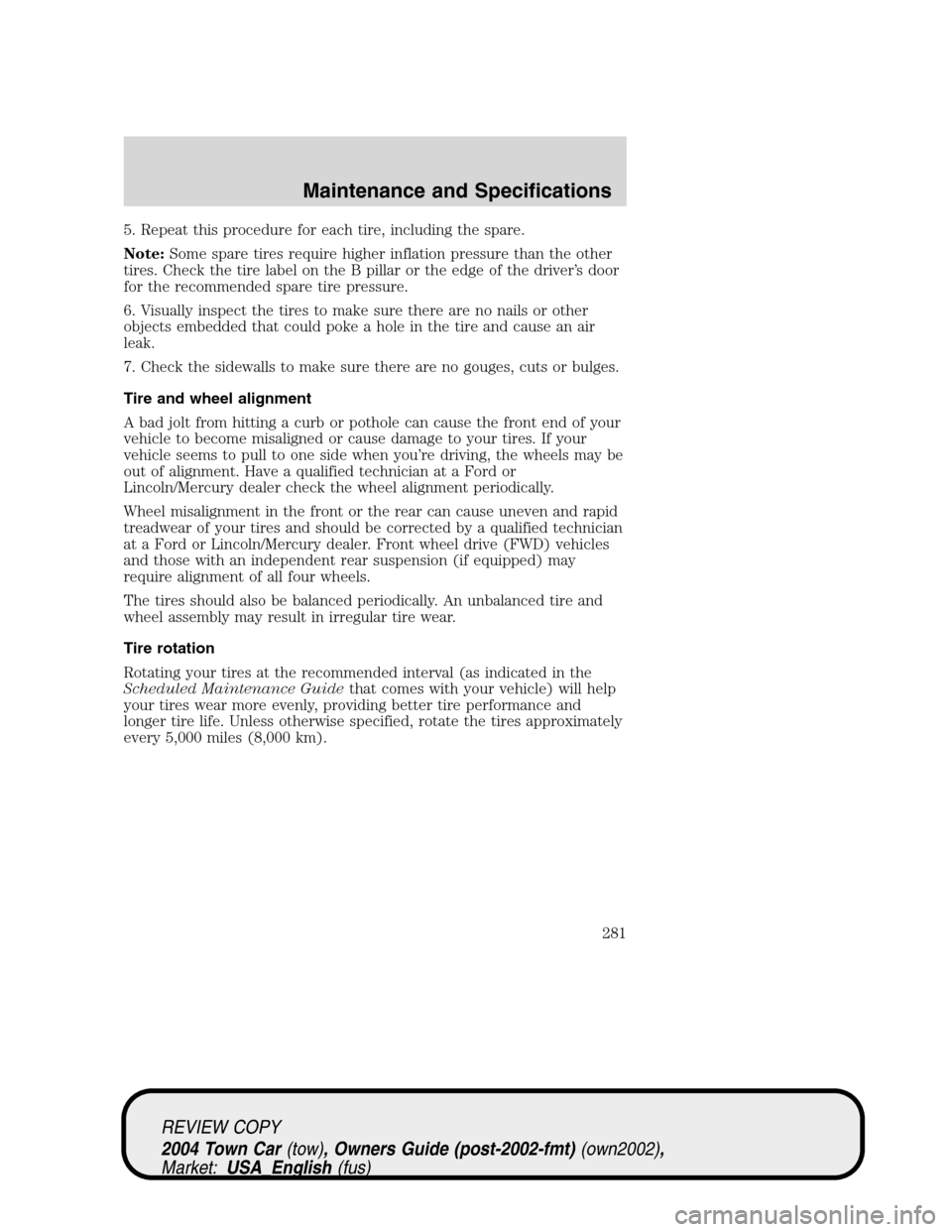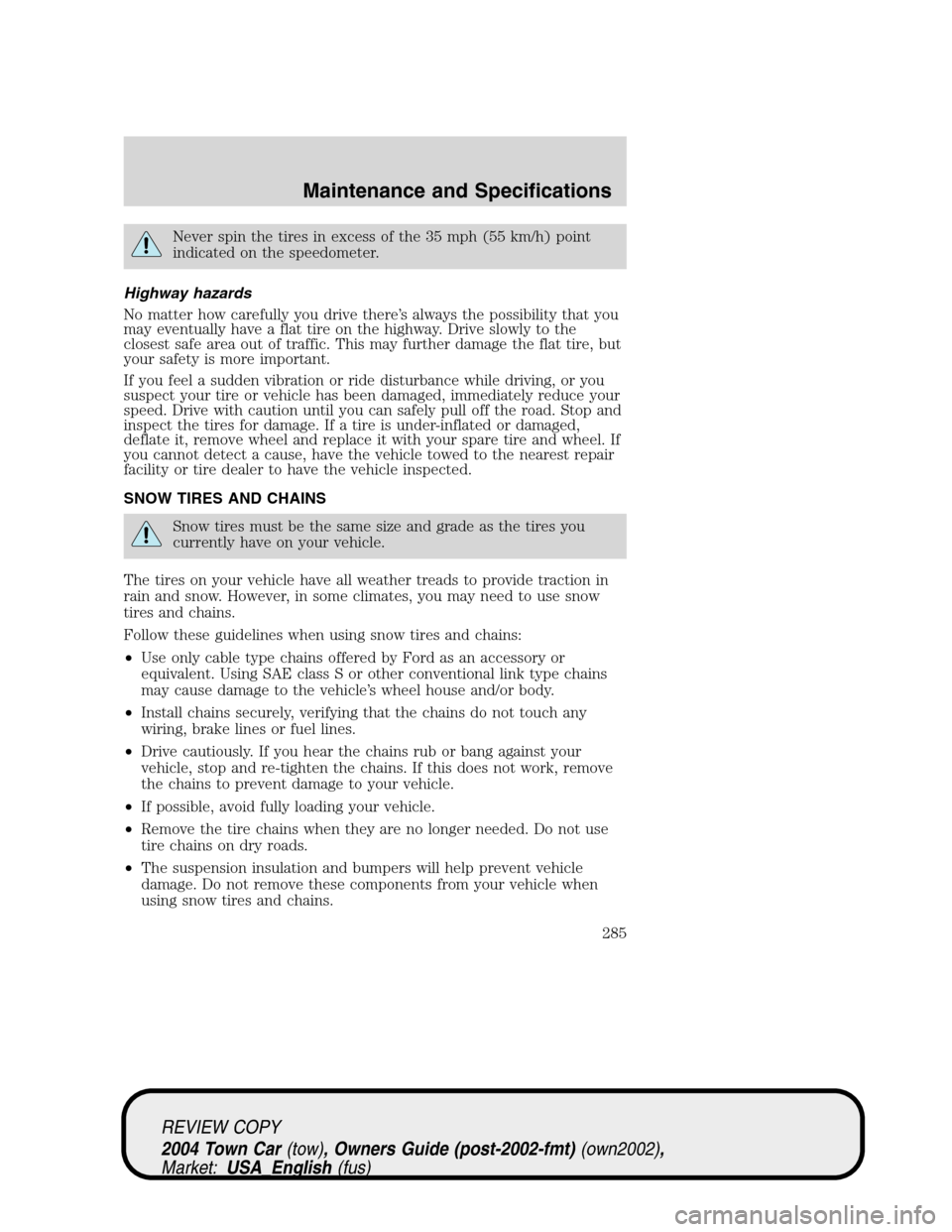Page 227 of 304
WRECKER TOWING
If you need to have your vehicle towed, contact a professional towing
service or, if you are a member of a roadside assistance program, your
roadside assistance service provider.
It is recommended that your vehicle be towed with a wheel lift or flatbed
equipment. Do not tow with a slingbelt. Ford Motor Company has not
approved a slingbelt towing procedure.
Before your vehicle can be towed, the air suspension control in the
luggage compartment must be turned to the OFF position (if equipped).
If the vehicle is towed by other means or incorrectly, vehicle
damage may occur.
Ford Motor Company produces a towing manual for all authorized tow
truck operators. Have your tow truck operator refer to this manual for
proper hook-up and towing procedures for your vehicle.
REVIEW COPY
2004 Town Car(tow), Owners Guide (post-2002-fmt)(own2002),
Market:USA_English(fus)
Roadside Emergencies
227
Page 281 of 304

5. Repeat this procedure for each tire, including the spare.
Note:Some spare tires require higher inflation pressure than the other
tires. Check the tire label on the B pillar or the edge of the driver’s door
for the recommended spare tire pressure.
6. Visually inspect the tires to make sure there are no nails or other
objects embedded that could poke a hole in the tire and cause an air
leak.
7. Check the sidewalls to make sure there are no gouges, cuts or bulges.
Tire and wheel alignment
A bad jolt from hitting a curb or pothole can cause the front end of your
vehicle to become misaligned or cause damage to your tires. If your
vehicle seems to pull to one side when you’re driving, the wheels may be
out of alignment. Have a qualified technician at a Ford or
Lincoln/Mercury dealer check the wheel alignment periodically.
Wheel misalignment in the front or the rear can cause uneven and rapid
treadwear of your tires and should be corrected by a qualified technician
at a Ford or Lincoln/Mercury dealer. Front wheel drive (FWD) vehicles
and those with an independent rear suspension (if equipped) may
require alignment of all four wheels.
The tires should also be balanced periodically. An unbalanced tire and
wheel assembly may result in irregular tire wear.
Tire rotation
Rotating your tires at the recommended interval (as indicated in the
Scheduled Maintenance Guidethat comes with your vehicle) will help
your tires wear more evenly, providing better tire performance and
longer tire life. Unless otherwise specified, rotate the tires approximately
every 5,000 miles (8,000 km).
REVIEW COPY
2004 Town Car(tow), Owners Guide (post-2002-fmt)(own2002),
Market:USA_English(fus)
Maintenance and Specifications
281
Page 285 of 304

Never spin the tires in excess of the 35 mph (55 km/h) point
indicated on the speedometer.
Highway hazards
No matter how carefully you drive there’s always the possibility that you
may eventually have a flat tire on the highway. Drive slowly to the
closest safe area out of traffic. This may further damage the flat tire, but
your safety is more important.
If you feel a sudden vibration or ride disturbance while driving, or you
suspect your tire or vehicle has been damaged, immediately reduce your
speed. Drive with caution until you can safely pull off the road. Stop and
inspect the tires for damage. If a tire is under-inflated or damaged,
deflate it, remove wheel and replace it with your spare tire and wheel. If
you cannot detect a cause, have the vehicle towed to the nearest repair
facility or tire dealer to have the vehicle inspected.
SNOW TIRES AND CHAINS
Snow tires must be the same size and grade as the tires you
currently have on your vehicle.
The tires on your vehicle have all weather treads to provide traction in
rain and snow. However, in some climates, you may need to use snow
tires and chains.
Follow these guidelines when using snow tires and chains:
•Use only cable type chains offered by Ford as an accessory or
equivalent. Using SAE class S or other conventional link type chains
may cause damage to the vehicle’s wheel house and/or body.
•Install chains securely, verifying that the chains do not touch any
wiring, brake lines or fuel lines.
•Drive cautiously. If you hear the chains rub or bang against your
vehicle, stop and re-tighten the chains. If this does not work, remove
the chains to prevent damage to your vehicle.
•If possible, avoid fully loading your vehicle.
•Remove the tire chains when they are no longer needed. Do not use
tire chains on dry roads.
•The suspension insulation and bumpers will help prevent vehicle
damage. Do not remove these components from your vehicle when
using snow tires and chains.
REVIEW COPY
2004 Town Car(tow), Owners Guide (post-2002-fmt)(own2002),
Market:USA_English(fus)
Maintenance and Specifications
285
Page 298 of 304

A
Accessory delay ........................114
Air bag supplemental restraint
system ................................165, 169
and child safety seats ............167
description ......................165, 169
disposal ....................................172
driver air bag ..................167, 170
indicator light .................169, 171
operation .........................167, 170
passenger air bag ...........167, 170
side air bag ..............................169
Air cleaner filter .......271–272, 286
Air suspension ...........................192
description ..............................192
Antifreeze
(see Engine coolant) ................252
Anti-lock brake system
(see Brakes) ..............................188
Anti-theft system ......................144
Audio system (see Radio) .........17
Automatic transmission
driving an automatic
overdrive .................................193
fluid, adding ............................269
fluid, checking ........................269
fluid, refill capacities ..............287
fluid, specification ..................290
Auxiliary power point ...............113
Axle
lubricant specifications ..288, 290
refill capacities ........................287
traction lok ..............................196
B
Battery .......................................250
acid, treating emergencies .....250jumping a disabled battery ....222
maintenance-free ....................250
replacement, specifications ...286
servicing ..................................250
BeltMinder .................................160
Brakes ........................................188
anti-lock ...................................188
anti-lock brake system (ABS)
warning light ...........................188
fluid, checking and adding ....268
fluid, refill capacities ..............287
fluid, specifications .........288, 290
lubricant specifications ..288, 290
shift interlock ..........................192
Bulbs ............................................96
C
Capacities for refilling fluids ....287
CD changer .................................21
CD-single premium .....................17
Cell phone use ..........................122
Certification Label ....................292
Changing a tire .........................216
Child safety restraints ..............172
child safety belts ....................172
Child safety seats ......................175
attaching with tether straps ..179
in front seat ............................176
in rear seat ..............................176
Cleaning your vehicle
engine compartment ..............238
instrument panel ....................240
interior .....................................240
plastic parts ............................239
washing ....................................237
waxing .....................................237
wheels ......................................238
REVIEW COPY
2004 Town Car(tow), Owners Guide (post-2002-fmt)(own2002),
Market:USA_English(fus)
Index
Index
298